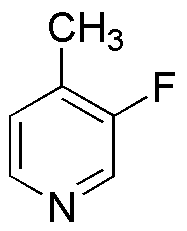3-Fluoro-4-methylpyridine is widely utilized in research focused on:
- Pharmaceutical Development: This compound serves as a key intermediate in the synthesis of various pharmaceuticals, particularly in the development of antiviral and antibacterial agents, enhancing the efficacy of drug formulations.
- Agricultural Chemicals: It is used in the formulation of agrochemicals, including pesticides and herbicides, providing improved selectivity and effectiveness against specific pests while minimizing environmental impact.
- Material Science: The compound is incorporated into the production of specialty polymers and coatings, offering enhanced thermal stability and chemical resistance, which are crucial for industrial applications.
- Research Reagents: As a versatile reagent, it is employed in various organic synthesis reactions, aiding researchers in developing new compounds with desired properties, thus accelerating innovation in chemical research.
- Flavor and Fragrance Industry: 3-Fluoro-4-methylpyridine is explored for its potential use in flavoring agents, contributing unique aromatic characteristics to food products and perfumes, appealing to consumer preferences.
General Information
Properties
Safety and Regulations
Applications
3-Fluoro-4-methylpyridine is widely utilized in research focused on:
- Pharmaceutical Development: This compound serves as a key intermediate in the synthesis of various pharmaceuticals, particularly in the development of antiviral and antibacterial agents, enhancing the efficacy of drug formulations.
- Agricultural Chemicals: It is used in the formulation of agrochemicals, including pesticides and herbicides, providing improved selectivity and effectiveness against specific pests while minimizing environmental impact.
- Material Science: The compound is incorporated into the production of specialty polymers and coatings, offering enhanced thermal stability and chemical resistance, which are crucial for industrial applications.
- Research Reagents: As a versatile reagent, it is employed in various organic synthesis reactions, aiding researchers in developing new compounds with desired properties, thus accelerating innovation in chemical research.
- Flavor and Fragrance Industry: 3-Fluoro-4-methylpyridine is explored for its potential use in flavoring agents, contributing unique aromatic characteristics to food products and perfumes, appealing to consumer preferences.
Documents
Safety Data Sheets (SDS)
The SDS provides comprehensive safety information on handling, storage, and disposal of the product.
Product Specification (PS)
The PS provides a comprehensive breakdown of the product’s properties, including chemical composition, physical state, purity, and storage requirements. It also details acceptable quality ranges and the product's intended applications.
Certificates of Analysis (COA)
Search for Certificates of Analysis (COA) by entering the products Lot Number. Lot and Batch Numbers can be found on a product’s label following the words ‘Lot’ or ‘Batch’.
*Catalog Number
*Lot Number
Certificates Of Origin (COO)
This COO confirms the country where the product was manufactured, and also details the materials and components used in it and whether it is derived from natural, synthetic, or other specific sources. This certificate may be required for customs, trade, and regulatory compliance.
*Catalog Number
*Lot Number
Safety Data Sheets (SDS)
The SDS provides comprehensive safety information on handling, storage, and disposal of the product.
DownloadProduct Specification (PS)
The PS provides a comprehensive breakdown of the product’s properties, including chemical composition, physical state, purity, and storage requirements. It also details acceptable quality ranges and the product's intended applications.
DownloadCertificates of Analysis (COA)
Search for Certificates of Analysis (COA) by entering the products Lot Number. Lot and Batch Numbers can be found on a product’s label following the words ‘Lot’ or ‘Batch’.
*Catalog Number
*Lot Number
Certificates Of Origin (COO)
This COO confirms the country where the product was manufactured, and also details the materials and components used in it and whether it is derived from natural, synthetic, or other specific sources. This certificate may be required for customs, trade, and regulatory compliance.


